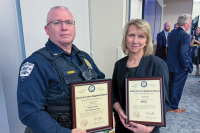Two schools, one campus: School year starts in Cashiers
 While most kids are just getting their new backpacks stocked or suffering through the first days of shift from summertime sleep schedules, students at Blue Ridge School in Cashiers are in the midst of their third week of the new school year.
While most kids are just getting their new backpacks stocked or suffering through the first days of shift from summertime sleep schedules, students at Blue Ridge School in Cashiers are in the midst of their third week of the new school year.
The first day of school for the little 370-student campus was Aug. 10, a good two weeks earlier than the bulk of Jackson County Schools, but the school’s start date isn’t the only unusual thing about it. For starters, Blue Ridge is technically two schools, not one, with Blue Ridge School serving children in kindergarten through sixth grade and Blue Ridge Early College going through grade 13. The early college is the reason for the early start date, said BREC principal Adam Holt. Partnering with Southwestern Community College to offer college classes to its teenage students, the school has to start at the same time college classes start. Because high schoolers and kindergartners all ride the same buses, the college schedule trickles down to affect the elementary grades, too.
“One of the challenges is blending two schools into one campus, because the expectations are so different K-6 than they are 7 to 13,” said Teri Walawender, principal of the elementary school.
Over in the elementary wing, kids are certainly aware of the older kids’ presence. They eat in the same cafeteria, ride the same buses and use the same gym. High schoolers make it to their classrooms as tutors, mentors and guest teachers, as when the high school’s German class came over to teach the younger students facts about Germany.
But stepping into Wanda Crisp’s kindergarten classroom left no doubt that the space was part of an elementary school. Kindergartners sat, crisscross applesauce, on a bright-colored carpet, eyes glued to a Smartboard that showed pictures of facial expressions to go with various emotions and the words to describe them. They enthusiastically mimicked their teacher in copying the faces shown, looking for the right expression to display as their “learning face.”
“Is it this one?” Crisp asked, showing a slide featuring a disgusted face.
Related Items
“No!” the class chorused.
“What about this one?” This time the board showed a collection of sad faces.
Finally, up came a slide showing happy faces, a perfect representation of the joy of learning. The students gladly replicated the face for their visitor from The Smoky Mountain News and were quick to talk about the exciting things they’d done so far this year — namely, watch a sheep get sheered and touch the fleece. A little boy named Dominik trotted over to point out the bag of fleece — holding his nose the whole time, because that stuff is stinky.
Over in the high school building, the scene is a little bit different. Blue Ridge offers a traditional high school curriculum, but it’s also an early college, integrating SCC courses into the curriculum through in-person instruction from Southwestern Community College professors, online classes and attendance at the Webster SCC campus. Students at the end of their 13th year can find themselves in possession of an associates degree, transfer credits to enter as a junior at a four-year institution or a certificate in a trade such as mechanics or cosmetology — all without paying any extra tuition.
“It’s pretty fantastic,” Walawender said.
But this particular Friday morning, the study carrels in the online learning room were empty of students, though still full of textbooks and taped-up photos of smiling teenagers on the particleboard dividers.
The students were instead gathered in one of nine classrooms, participating in one of a variety of club offerings. A darkened classroom held the 21st-century film club, currently watching “Memoirs of a Geisha,” which they would discuss later. Over in the row of temporary buildings the glee club worked on a version of Lorde’s song “Royals,” and next door a cluster of guitar-clutching teenagers strummed the gospel tune “Unclouded Day.”
The 40-minute club block is offered two Fridays each month, with the remaining Fridays including blocks for advisory club — kind of like a mentorship group in which small groups of students meet with a designated teacher — and skills day, which covers topics like plagiarism, note taking and budgeting.
Blue Ridge’s small size — most grade levels have somewhere between 25 and 35 students — allows it to be a bit more flexible, to try new approaches and respond to perceived gaps in the system. That’s what drove the formation of skills day, new this year.
“My staff got together over the summer and decided that there were a few skills that we felt our students needed by the time they graduated from high school,” Holt explained. “Through the process we decided to try a different Friday schedule where students attend three different opportunities: clubs, advisory groups and a skills day.”
The elementary school is similarly responsive to needs, this year launching a pair of combined-grade classes — one for first and second graders, the other for third and fourth graders.
“This year’s a new approach,” Walawender said. “Traditionally in a combined class you would put kids who are self-motivated, that you can give them direct instruction, and they can work independently while you work with another group.”
Instead, the combined classes are an intervention, providing a place for students who are struggling in a given subject to learn in a flexible environment, benefiting from a smaller class size and high number of teachers.
Sarah Cline, a second-year teacher who’s worked at Blue Ridge for both years, teaches the first/second grade science class, where she, a teaching assistant and a student tutor work with a group of about 15 students.
“We kind of just look through what first graders need to know in science and what second graders need,” Cline said. Then, she teaches the parts of the two curricula that are the same and differentiates based on the student’s grade and comprehension to drive home the rest.
“It’s not difficult to do,” she said of combining the grades.
Having the student tutors to lean on — high school kids who have some free time from their SCC classes — also makes things easier.
“They look up to the older kids,” Cline said of her students. They see that those kids are working hard, doing college classes, and decide they want to do that one day, too.
“Even though we’re two schools on paper, we’re using this campus together and sharing it for the benefit of all students,” Holt added.
Walawender’s also of the opinion that the shared campus means fewer behavioral issues among the high schoolers.
“They’re typical kids, but I feel like they just are aware,” she said. “When the little guys are around, they’re not as rambunctious as they would be at a regular high school.”
It’s an interesting dynamic, different than that encountered at the vast majority of public high schools in North Carolina. There are very few K-12 schools in the state, and a disproportionate number are located in Western North Carolina.
Blue Ridge has its challenges — it can be hard to attract teachers, because few of them can afford to live in Cashiers and therefore must commute. At the moment, the school is dealing with a staffing shortage. And as with all small schools, the economy of scale can be an issue when it comes to offerings such as music, sports and elective classes.
But in the same way, the school’s strength is in its size. It’s a school home that kids know from the time they learn to read until they’re filling out college applications. Classmates become siblings, and siblings become classmates.
“It is like family,” Walawender said.













